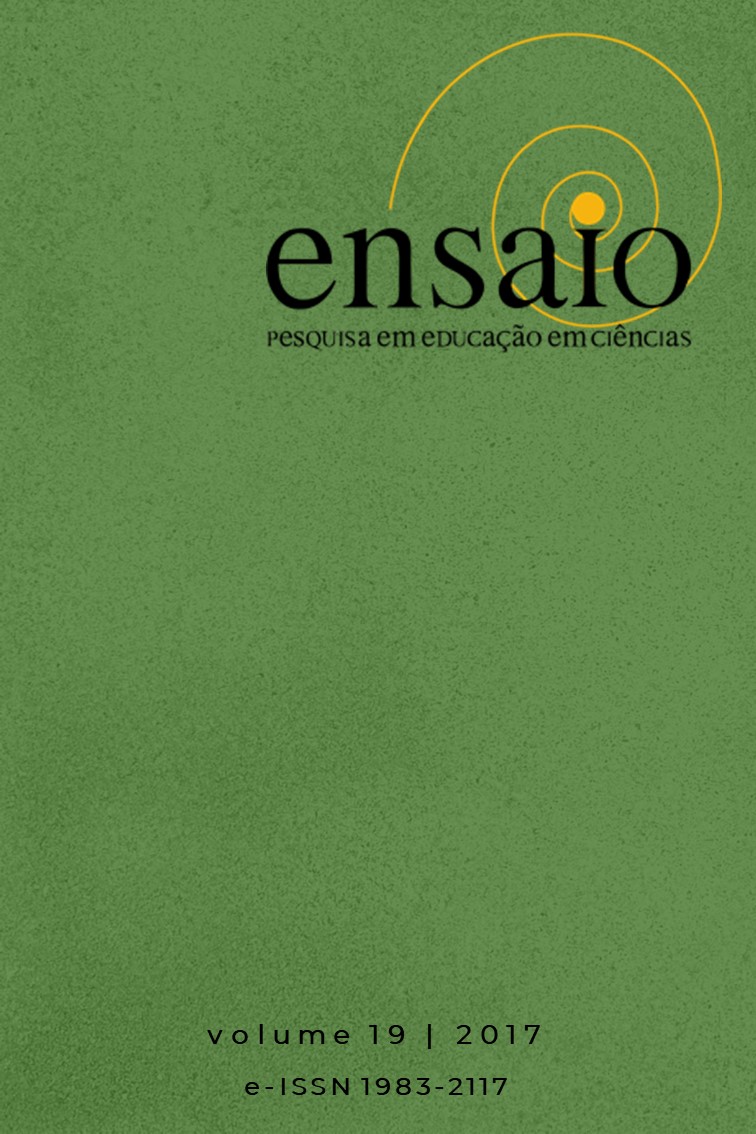AFFORDANCES DOS MATERIAIS COMO INDUTORES DE EQUÍVOCOS DURANTE EXPERIMENTOS PARA O ENSINO DE FÍSICA
AFFORDANCES OF THE OBJECTS AS ERRORS INDUCTORS DURING PHYSICS TEACHING EXPERIMENTS
DOI:
https://doi.org/10.1590/1983-21172017190111%20Palavras-chave:
Educação científica; Affordances; Semiótica; Experimentos.Resumo
O artigo revisita o conceito de affordance e dirige sua leitura para o contexto das atividades experimentais para o ensino de física. O conceito de affordance é tratado segundo o significado de reconhecimento imediato que estudantes atribuem a um material ou instrumento em interação com eles, o que gera frequentes comportamentos incorretos. Os equívocos são devidos a inerentes características morfológicas de construção dos objetos que tendem a gerar interpretações semióticas incorretas de como usá-los. O trabalho apresenta ocorrências de enganos cometidos frequentemente por licenciandos de física quando em processo de aprendizagem de experimentos voltados para o ensino médio. O estudo mostra que os tipos singulares de equívocos cometidos podem ser explicados à luz do conceito de affordances.
The article revisits the affordances concept and directs its reading to the context of experimental activities on physics teaching. Here, affordances concept is interpreted as the immediate meaning that students attribute to a material or tool when interacting with it, and that association generates frequent incorrect recognition behaviours. These errors are due to objects construction’s inherent morphological characteristics that tend to generate students’ incorrect semiotic interpretations of how to use them. The work presents occurrences of mistakes repeatedly committed by undergraduate physics teachers when in the process of learning experiments for high school. The study shows that the kinds of mistakes committed by students can be explained by the affordances concept.
Referências
BROWN, J.; STILLMAN, G.; HERBERT, S. Can the notion of affordances be of use in the design of a technology enriched Mathematics curriculum? In: I. PUTT, R.; FARAGHER; McLEAM. N (Eds) Proceedings of the 27th Annual Conference of the Mathematics Education Research Group of Australasia, Sydney, MERGA, v. 1, p. 119-126, 2004. [ Links ]
DUVAL, R. Semiosis y pensamiento humano: registros semióticos y aprendizajes intelectuales. Santiago de Cali: Universidad del Vale, Instituto de Educación y Pedagogía, 2004. [ Links ]
FREDLUND, T.; AIREY, J.; LINDER, C. Exploring the role of physics representations: an illustrative example from students sharing knowledge about refraction. European Journal of Physics, v. 33, p. 657-666, 2012. [ Links ]
GIBSON, J. The ecological approach to visual perception. New York: Lawrence Erlbaum Associates, 1986. [ Links ]
HAMMOND, M. What is an affordance and can it help us understand the use of ICT in education? Education and Information Technologies, v. 15, p. 205-217, 2010. [ Links ]
HOBAN, G.; NIELSEN, W. Creating a narrated stop-motion animation to explain science: the affordances of “slowmotion” for generating discussion, Teaching and Teacher Education, v. 42, p. 68-78, 2014. [ Links ]
KOZMA, R. The material features of multiple representations and their cognitive and social affordances for science understanding. Learning and Instruction, v. 13, p. 205-226, 2003. [ Links ]
KRESS, G.; JEWITT, C.; OGBORN, J.; TSATSARELIS, C. Multimodal teaching and learning: The rhetorics of the science classroom. London: Continuum, 2001. [ Links ]
LABURÚ, C. E.; SILVA, O. H. M.; ZÔMPERO, A. F. Significados de eletrostática interpretados por meio da gesticulação de estudantes. Ciência & Educação, v. 21, n. 4, p. 851-867, 2015. [ Links ]
McGRENERE, J.; HO, W. Affordances: clarifying and evolving a concept. In: Proceedings of Graphic Interface 2000. Montreal, May, p. 179-186, 2000.[Links]
NORMAN, D. The psychology of everyday things. New York: Basic Books, 1998. [ Links ]
Oliveira, M. k. Vygotsky, aprendizado e desenvolvimento. Um processo sócio-histórico. São Paulo: Editora Scipione, 1993. (Série Pensamento e Ação no Magistéro) [ Links ]
Prain, V.; Waldrip, B. An exploratory study of teachers’ and students’ use of multi-modal representations of concepts in primary science. International Journal of Science Education, v. 28, n. 15, p. 1843-1866, 2006. [ Links ]
RADFORD, L. On the cognitive, epistemic, and ontological roles of artefacts. In: G. GUEUDET, G.; PEPIN, B.; TROUCHE, L. (Eds.). From test to “lived” resources. New York: Springer, 2012. p. 238-288. [ Links ]
SANTAELLA, L. A teoria geral dos signos: semiose e autogeração. São Paulo: Ática, 1995. [ Links ]
SANTAELLA, L. Semiótica aplicada. São Paulo: Thomson, 2005. [ Links ]
SANTAELHA, L.; NÖTH, W. Comunicação & semiótica. São Paulo: Hacker Editores 2004. 248 p. [ Links ]
WALDRIP, B.; PRAIN, V.; CAROLAN, J. Using multi-modal representations to improve learning in junior secondary science. Research in Science Education, v. 40, p. 65-80, 2010. [ Links ]
WU, H-K.; PUNTAMBEKAR, S. Pedagogical Affordances of Multiple External Representations in Scientific Processes. Journal of Science Educational Technology, v. 21, p. 754-767, 2012. [ Links ]
VOLLI, U. Manual de semiótica.2. ed. São Paulo: Edições Loyola, 2007 [ Links ]


